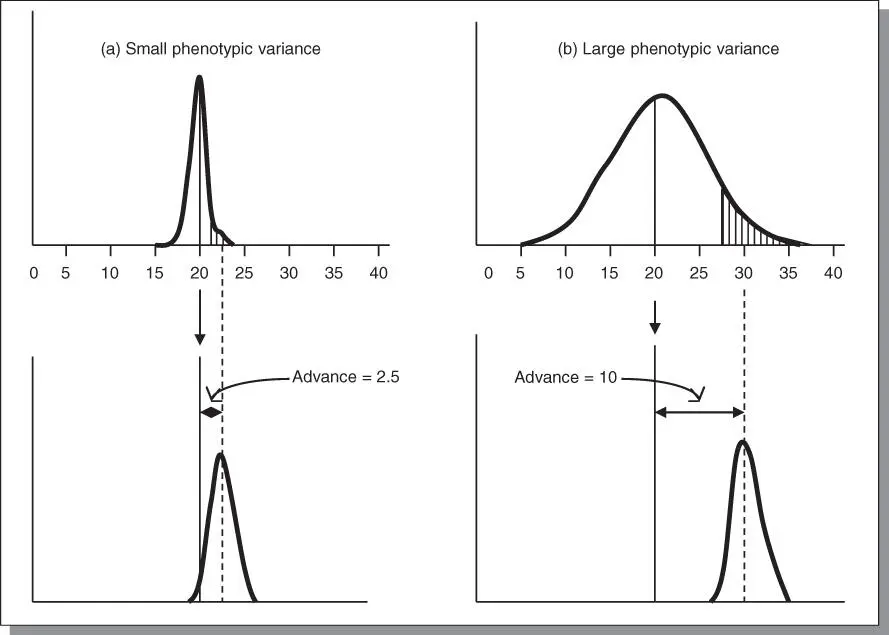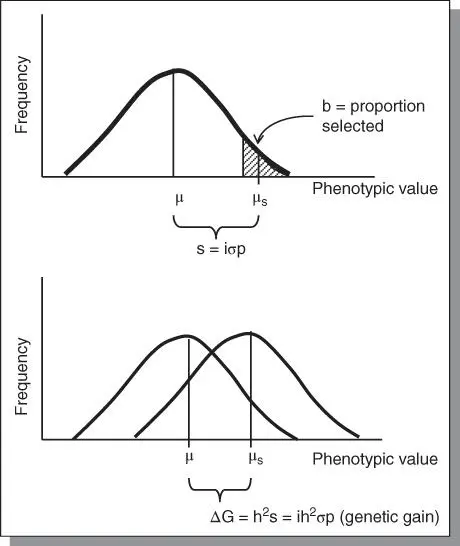
Figure 4.3The effect of phenotypic variance on genetic advance. If the phenotypic variance is too small, the genetic variability from which to select will be limited, resulting in a smaller genetic gain. The reverse is true when the phenotypic variance is large.
In principle, the prediction of response is valid for only one generation of selection. This is because a response to selection depends on the heritability of the trait estimated in the generation from which parents are selected. To predict the response in subsequent generations, heritabilities must be determined in each generation. Heritabilities are expected to change from one generation to the next because, if there is a response, it must be accompanied by change in gene frequencies on which heritability depends. Also, selection of parents reduces the variance and the heritability, especially in the early generations. It should be pointed out that heritability changes are not usually large.
If heritability is unity (V A= V P; no environmental variance) progress in a breeding program would be perfect, and the mean of offspring would equal the mean of the selected parents. On the other hand, if heritability is zero, there would be no progress at all (R = 0).
The response in one generation may be mathematically expressed as

where
Xo = mean phenotype of the offspring of selected parents;
Xp = mean phenotype of the whole parental generation;
R = the advance in one generation of selection;
h2 = heritability;
σ = phenotypic standard deviation of the parental population;
i = intensity of selection;
∆G = genetic gain or genetic advance.
This equation has been suggested by some to be one of the fundamental equations of plant breeding that must be understood by all breeders, hence called the breeder's equation. The equation is graphically illustrated in Figure 4.4. The factor “i,” the intensity of selection (standardized selection differential), is a statistical factor that depends on the fraction of the current population retained to be used as parents for the next generation. If the entire population is used, the selection intensity is 0. The breeder may consult statistical tables for specific values (e.g. at 1% = 2.668; at 5% i = 2.06; at 10% i = 1.755). The breeder must decide the selection intensity to impose to achieve a desired objective. The selection differential can be predicted if the phenotypic values of the trait of interest are normally distributed, and the selection is by truncation (i.e. the individuals are selected solely in order of merit according to their phenotypic value – no individual being selected is less good than any of those rejected).

Figure 4.4Genetic gain or genetic advance from selection indicates the progress plant breeders make from one generation to another based on the selection decisions they make.
The response equation is effective in predicting response to selection, provided the heritability estimate (h 2) is fairly accurate. In terms of practical breeding, the parameters for the response equation are seldom available and hence not widely used. It is instructive to state that predicted response (theoretical estimate based on heritability and tabulated selection intensity) is different from realized response (what the breeder actually observes in the next generation following selection). Over the long haul, repeated selection tends to fix favorable genes, resulting in a decline in both heritability and phenotypic standard deviation. Once genes have been fixed, there will be no further response to selection.
Example:
|
X |
σp |
V P |
V A |
V E |
| Parents |
15 |
2 |
6 |
4 |
3 |
| Offspring |
20.2 |
15 |
4.3 |
2.5 |
3 |

Parents for i at p = 10% = 1.755 (read from tables and assuming a very large population)
Offspring
Generally, as selection advances to higher generations, genetic variance and heritability decline. Similarly, the advance from one generation to the next declines, while the mean value of the trait being improved increases.
4.2.12 Concept of correlated response
Correlation is a measure of the degree of association between traits as previously discussed. This association may be on the basis of genetics or may be non‐genetic. In terms of response to selection, genetic correlation is what is useful. When it exists, selection for one trait will cause a corresponding change in other traits that are correlated. This response to change by genetic association is called correlated response. Correlated response may be caused by pleiotropism or linkage disequilibrium. Pleiotropism is the multiple effect of a single gene (i.e. a single simultaneously affects several physiological pathways). In a random mating population, the role of linkage disequilibrium in correlated response is only important if the traits of interest are closely linked.
In calculating correlated response, genetic correlations should be used. However, the breeder often has access to phenotypic correlation and can use them if they were estimated from values averaged over several environments. Such data tend to be in agreement with genetic correlation. In a breeding program the breeder, even while selecting simultaneously for multiple traits, has a primary trait of interest and secondary traits. The correlated response (CRy) to selection in the primary trait (y) for a secondary trait (x) is given by

where h xand h yare square roots of the heritabilities of the two respective traits and ρg is the genetic correlation between traits. This relationship may be reduced to

since h y= √(V Gy/Vpy)
It is clear that the effectiveness of indirect selection depends on the magnitude of genetic correlation and the heritability of the secondary traits being selected. Further, given the same selection intensity and a high genetic correlation between the traits, indirect selection for the primary trait will be more effective than directional selection, if heritability of the secondary trait is high (ρ gh x> h y). Such a scenario would occur when the secondary trait is less sensitive to environmental change (or can be measured under controlled conditions). Also, when the secondary trait is easier and more economic to measure, the breeder may apply a higher selection pressure to it.
Correlated response has wider breeding application in homozygous, self‐fertilizing species and apomicts. Additive genetic correlation is important in selection in plant breeding. As previously discussed, the additive breeding value is what is transferred to offspring and can be changed by selection. Hence, where traits are additively genetically correlated, selection for one trait will produce a correlated response in another.
Читать дальше


















